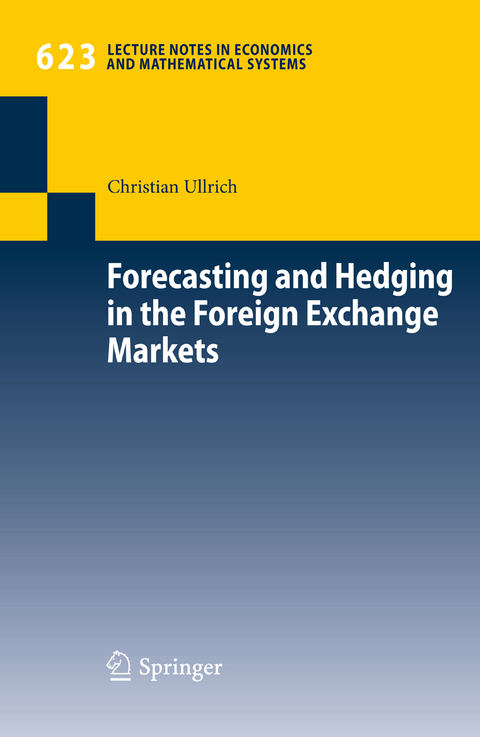Forecasting and Hedging in the Foreign Exchange Markets
Seiten
2009
|
2009
Springer Berlin (Verlag)
978-3-642-00494-0 (ISBN)
Springer Berlin (Verlag)
978-3-642-00494-0 (ISBN)
From the complexity of the foreign exchange market and related decision problems, the author derives the necessity to use tools from machine learning and artificial intelligence, and to combine such methods with sophisticated financial modeling techniques.
Historical and recent developments at international ?nancial markets show that it is easy to loose money, while it is dif?cult to predict future developments and op- mize decision-making towards maximizing returns and minimizing risk. One of the reasons of our inability to make reliable predictions and to make optimal decisions is the growing complexity of the global economy. This is especially true for the f- eign exchange market (FX market) which is considered as one of the largest and most liquid ?nancial markets. Its grade of ef?ciencyand its complexityis one of the starting points of this volume. From the high complexity of the FX market, Christian Ullrich deduces the - cessity to use tools from machine learning and arti?cial intelligence, e.g., support vector machines, and to combine such methods with sophisticated ?nancial mod- ing techniques. The suitability of this combination of ideas is demonstrated by an empirical study and by simulation. I am pleased to introduce this book to its - dience, hoping that it will provide the reader with interesting ideas to support the understanding of FX markets and to help to improve risk management in dif?cult times. Moreover, I hope that its publication will stimulate further research to contribute to the solution of the many open questions in this area.
Historical and recent developments at international ?nancial markets show that it is easy to loose money, while it is dif?cult to predict future developments and op- mize decision-making towards maximizing returns and minimizing risk. One of the reasons of our inability to make reliable predictions and to make optimal decisions is the growing complexity of the global economy. This is especially true for the f- eign exchange market (FX market) which is considered as one of the largest and most liquid ?nancial markets. Its grade of ef?ciencyand its complexityis one of the starting points of this volume. From the high complexity of the FX market, Christian Ullrich deduces the - cessity to use tools from machine learning and arti?cial intelligence, e.g., support vector machines, and to combine such methods with sophisticated ?nancial mod- ing techniques. The suitability of this combination of ideas is demonstrated by an empirical study and by simulation. I am pleased to introduce this book to its - dience, hoping that it will provide the reader with interesting ideas to support the understanding of FX markets and to help to improve risk management in dif?cult times. Moreover, I hope that its publication will stimulate further research to contribute to the solution of the many open questions in this area.
Motivation.- Analytical Outlook.- Foreign Exchange Market Predictability.- Equilibrium Relationships.- Market Efficiency Concepts.- Views from Complexity Theory.- Conclusions.- Exchange Rate Forecasting with Support Vector Machines.- Statistical Analysis of Daily Exchange Rate Data..- Support Vector Classification.- Description of Empirical Study and Results.- Exchange Rate Hedging in a Simulation/Optimization Framework.- Preferences over Probability Distributions.- Problem Statement and Computational Complexity.- Model Implementation.- Simulation/Optimization Experiments.- Contributions of the Dissertation.- Exchange Rate Forecasting with Support Vector Machines.- References.- Exchange Rate Hedging in a Simulation/Optimization Framework.
| Erscheint lt. Verlag | 12.6.2009 |
|---|---|
| Reihe/Serie | Lecture Notes in Economics and Mathematical Systems |
| Zusatzinfo | XVIII, 207 p. 43 illus. |
| Verlagsort | Berlin |
| Sprache | englisch |
| Maße | 155 x 235 mm |
| Gewicht | 351 g |
| Themenwelt | Wirtschaft ► Allgemeines / Lexika |
| Wirtschaft ► Volkswirtschaftslehre ► Makroökonomie | |
| Schlagworte | Analysis • Artificial Intelligence • classification • Complexity • Complexity theory • Computational Finance • Decision-Making • Distribution • Finance • financial modeling • Foreign Exchange Market Complexity • Hedging • machine learning • Modeling • Motivation • Optimization • Quantitative Finance • Simulation • Statistical Analysis |
| ISBN-10 | 3-642-00494-6 / 3642004946 |
| ISBN-13 | 978-3-642-00494-0 / 9783642004940 |
| Zustand | Neuware |
| Haben Sie eine Frage zum Produkt? |
Mehr entdecken
aus dem Bereich
aus dem Bereich
Volkswirtschaftslehre für eine sich ändernde Welt
Buch | Hardcover (2024)
De Gruyter Oldenbourg (Verlag)
44,95 €
Kompakt und prüfungsrelevant für Wirtschaftswissenschaftler
Buch | Softcover (2021)
Vahlen, Franz (Verlag)
11,90 €
Makroökonomie, Wirtschaftspolitik und nachhaltige Entwicklung
Buch | Hardcover (2022)
Vahlen (Verlag)
49,80 €




